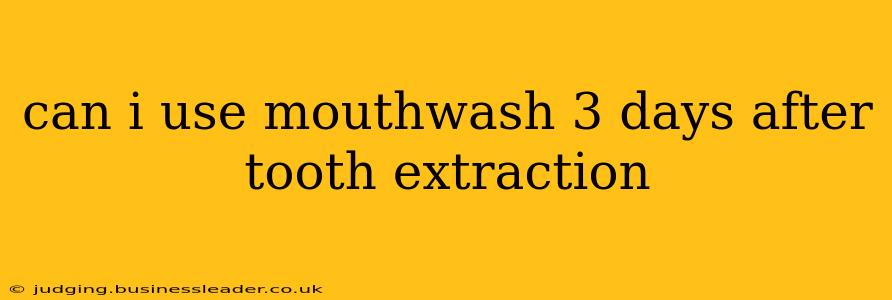Can I Use Mouthwash 3 Days After Tooth Extraction?
The short answer is: probably, but with caution. Using mouthwash after a tooth extraction can be beneficial for cleaning and preventing infection, but it's crucial to do so correctly and at the right time. Rushing the process can disrupt the healing clot and lead to complications like dry socket, a painful and potentially serious condition.
This post will answer common questions surrounding mouthwash use post-extraction, guiding you towards a healthy recovery.
When Can I Start Using Mouthwash After Tooth Extraction?
Generally, dentists recommend waiting at least 24 to 72 hours after a tooth extraction before using mouthwash. This allows the blood clot to form properly, a critical first step in the healing process. Using mouthwash too soon can dislodge this clot, leading to dry socket. Three days is usually within the safe window, but always follow your dentist's specific instructions. They know the specifics of your case and the type of extraction performed.
What Type of Mouthwash Should I Use After Tooth Extraction?
Not all mouthwashes are created equal. Avoid mouthwashes containing alcohol, as alcohol can irritate the extraction site and impede healing. Opt for a gentle, alcohol-free mouthwash that's specifically designed for post-operative oral care. Look for those containing antiseptic ingredients like chlorhexidine or cetylpyridinium chloride. However, even these should be used sparingly, following the dentist's recommendation.
How Do I Use Mouthwash After Tooth Extraction?
When you do start using mouthwash, use it gently. Avoid swishing vigorously, which could disturb the healing clot. Instead, gently rinse your mouth for a short period (about 30 seconds), then spit it out. Do not swish it aggressively near the extraction site.
What Are the Risks of Using Mouthwash Too Soon After Tooth Extraction?
The primary risk is dry socket, also known as alveolar osteitis. This occurs when the blood clot that forms in the extraction socket is dislodged, exposing the underlying bone and nerve endings. This results in intense pain, bad breath, and a possible delay in healing. It's far more likely to occur if the blood clot is disturbed.
What Are the Signs of Dry Socket?
Recognizing the signs of dry socket is important for prompt treatment. Symptoms typically include:
- Severe pain, often starting a few days after the extraction.
- A bad taste or odor in your mouth.
- Visible empty socket.
- Delayed healing.
What Should I Do If I Think I Have Dry Socket?
If you experience any of the signs of dry socket, contact your dentist immediately. They can assess the situation and provide appropriate treatment, often involving a medicated dressing to promote healing.
What Other Tips Should I Follow for Post-Extraction Care?
Beyond mouthwash, follow these post-extraction care tips:
- Avoid smoking and drinking through a straw. Both can disrupt the blood clot.
- Eat soft foods for the first few days to avoid disturbing the extraction site.
- Apply gentle pressure to the extraction site with a gauze pad as directed by your dentist.
- Keep the area clean by gently brushing your teeth, avoiding the extraction site.
- Get plenty of rest to aid in the healing process.
Remember, every individual heals at a different pace. Always follow your dentist's instructions explicitly for the best outcome. If you have any concerns, don't hesitate to contact their office for clarification. They're the best source of information regarding your specific situation.
